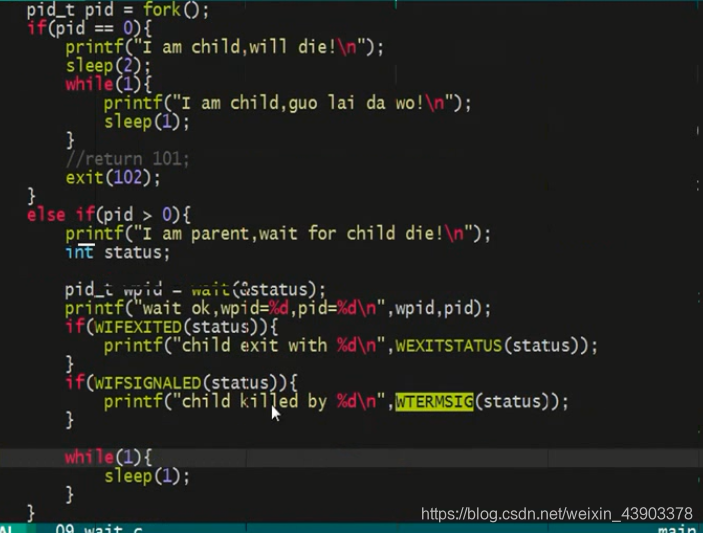ps:疑惑的地方,1 进程pcb的概念, 还有 ulimit -a 显示的信息 是一个进程可以最大占用资源的上限吗? 还有 文件描述符的概念?? 这里不是很明白!记录一下2还有WIFEXITED
- 孤儿进程 与僵尸进程
孤儿进程: 子进程运行,父进程终止, 子进程就是孤儿进程
僵尸进程:进程终止,父进程尚未回收,子进程残留资源(pcb)存放于内核中,变成(Zombie)僵尸进程
- wait函数 回收子进程
man wait 看到的是命令提示
man 2 wait 看到的是函数原型
pid_t wait(int *status);
作用:a. 阻塞等待b. 回收子进程资源c. 查看死亡原因
#include <sys/types.h>
#include <sys/wait.h>
pid_t wait(int *status);status 传出参数返回值 调用成功:返回终止子进程的pid,调用失败:返回 -1
子进程死亡原因:a. 正常死亡 WIFEXITED如果WIFEXITED为真,使用WEXITSTATUS ,得到退出状态b. 非正常死亡如果WIFSIGNALED为真,使用WTERMSJG, 得到信号以下是代码示例

以下是 wait 于 waitpid函数 相关文档介绍
If status is not NULL, wait() and waitpid() store status information in the int to which it points.
This integer can be inspected with the following macros (which take the integer itself as an argument,
not a pointer to it, as is done in wait() and waitpid()!):WIFEXITED(status)returns true if the child terminated normally, that is, by calling exit(3) or _exit(2), or byreturning from main().WEXITSTATUS(status)returns the exit status of the child. This consists of the least significant 8 bits of thestatus argument that the child specified in a call to exit(3) or _exit(2) or as the argumentfor a return statement in main(). This macro should be employed only if WIFEXITED returnedtrue.WIFSIGNALED(status)returns true if the child process was terminated by a signal.WTERMSIG(status)returns the number of the signal that caused the child process to terminate. This macro shouldbe employed only if WIFSIGNALED returned true.pid_t waitpid(pid_t pid, int *status, int options);pida. <-1 -组idb. -1 回收任意c. 0 回收和调用进程组id相同组内的子进程d. >0 回收指定的pidoptionsa. 0与wait相同,也会阻塞b. WNOHANG 如果没有当前子进程立即退出的,会立刻返回返回值a.如果设置了,WNOHANG,1).如果没有子进程退出,返回02).如果有子进程退出,返回退出的pidb. 失败返回-1(没有子进程)
调用案例

以下是 pid_t pid 这个参数对应的不同值的介绍
ps: 0 这个参数不明白是什么意思??? 这里记录一下
< -1 meaning wait for any child process whose process group ID is equal to the absolute value ofpid.-1 meaning wait for any child process.0 meaning wait for any child process whose process group ID is equal to that of the callingprocess.> 0 meaning wait for the child whose process ID is equal to the value of pid.- 用wait 回收多个子进程 调用案例

- 用waitpid函数回收多个子进程调用案例
#include "stdio.h"
#include "sys/types.h"
#include "sys/wait.h"
#include "stdlib.h"
#include "unistd.h"int main() {int i;int n = 5;pid_t pid;pid_t wpid;for(i=0; i<n; ++i) {pid = fork();if(pid == 0) {break;}}if(i==5) {printf("my is father progress !\n");while(1) {wpid = waitpid(-1, NULL, WNOHANG);if(wpid==-1) {printf("zi ji cheng hui shou wan bi\n");break;} else if (wpid>0) {printf("hui shou de zi jin cheng pid is%d\n", wpid);}} while(1) {sleep(1);}}if(i<5) {printf("my is son progress! my pid is%d\n", getpid());} return 0;
}- 创建子进程,调用fork之后,在子进程调用自定义程序(段错误,浮点型错误),用waitpid回收,查看退出状态
代码示例:
#include "stdio.h"
#include "stdlib.h"
#include "sys/types.h"
#include "sys/wait.h"
#include "unistd.h"int main () {pid_t pid;pid_t wpid;int status;pid = fork();if(pid==0) {// zi jin chengexecl("./test3gz.out", "test3gz.out", NULL);} else {while(1) {wpid = waitpid(-1, &status, WNOHANG);if(wpid == -1) {printf("suo you zi jin cheng tui chu\n");break;} else if(wpid>0) {printf("tui chu de zi jin cheng pid shi%d\n", wpid);printf("status is %d\n", status);if(WIFEXITED(status)) {printf("zheng chang tui chu return status is %d\n", WEXITSTATUS(status));}if(WIFSIGNALED(status)) {printf("zi ji cheng kill by signal is %d\n", WTERMSIG(status));}}} while(1) {sleep(1);}}return 0;
}
输出:
a. 当test3gz.out没有发生浮点型错误的时候
this is test3gz.c
k = 3
tui chu de zi jin cheng pid shi18293
status is 0
zheng chang tui chu return status is 0
suo you zi jin cheng tui chu
b. 当test3gz.out发生浮点型错误的时候
tui chu de zi jin cheng pid shi18278
status is 136
zi ji cheng kill by signal is 8
suo you zi jin cheng tui chu- 子进程与父进程共享文件描述符表



















